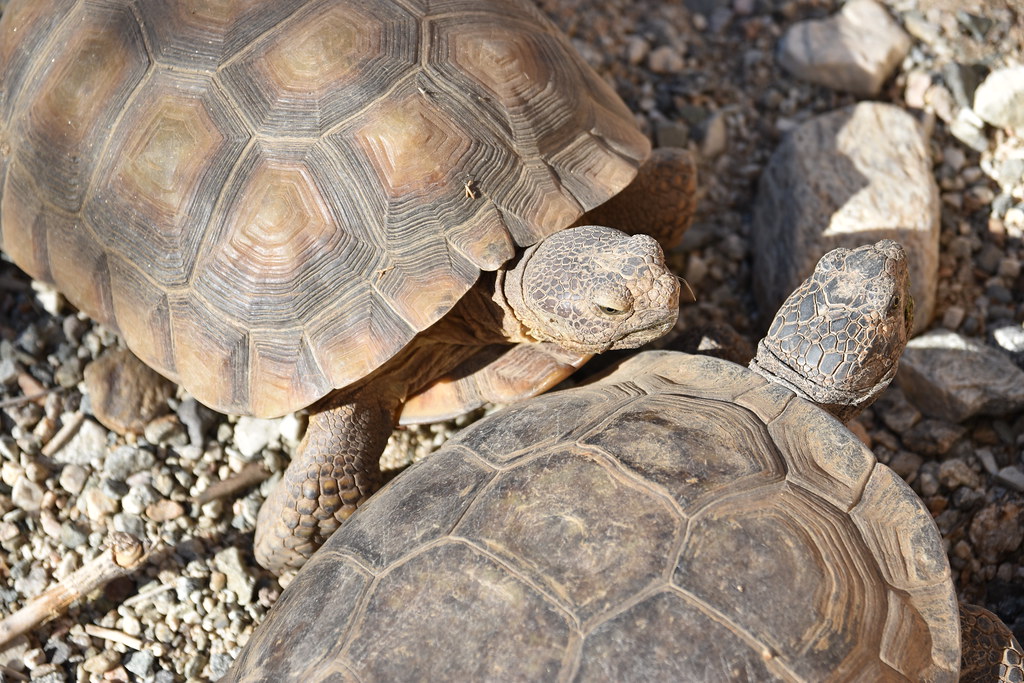
Image Source: Flickr
Tortoises need extra care during the winter. To keep them warm, you must provide a suitable enclosure and maintain a consistent room temperature. Place a heating lamp or pad in one corner of the enclosure, and line the sides with insulation. Create a basking spot with a heat lamp or ceramic heater, and it should reach 90-100°F (32-38°C). Don’t rely only on artificial heat; your tortoise should get access to natural sunlight too. Beware of heat rocks or stones, as they can cause burns or other injuries. Winter is here, and even tortoises need some warmth!
Key Takeaways
- Provide a suitable indoor habitat: During the winter months, it is important to bring your tortoise indoors to protect it from the cold temperatures. Create a warm and comfortable habitat with proper heating and lighting.
- Use a heat lamp or heating pad: Tortoises require a specific temperature range to thrive. Use a heat lamp or heating pad to maintain the ideal temperature in their enclosure. Make sure to monitor the temperature regularly to ensure it remains consistent.
- Provide a hiding spot: Tortoises naturally seek shelter when they feel cold or threatened. Offer a hiding spot in their enclosure, such as a small cave or box, where they can retreat to when they need to warm up.
- Adjust the diet: During the winter, tortoises tend to be less active and may require less food. Adjust their diet accordingly to prevent overfeeding and weight gain. Consult a veterinarian or reptile specialist for specific dietary recommendations.
- Maintain proper humidity levels: Tortoises also need a certain level of humidity to stay healthy. Use a hygrometer to monitor the humidity in their enclosure and provide a humidifier or misting system if necessary.
- Avoid sudden temperature changes: Tortoises are sensitive to sudden temperature fluctuations. Keep their enclosure away from drafty areas or sources of cold air, such as windows or doors. Ensure a stable and consistent temperature to prevent stress or illness.
- Regular health check-ups: Schedule regular check-ups with a reptile veterinarian to ensure your tortoise is in good health. They can provide guidance on winter care and address any potential issues or concerns.
- Remember, providing a warm and comfortable environment for your tortoise during the winter is crucial for its well-being. By following these key takeaways, you can help keep your tortoise safe and healthy throughout the colder months.
Understanding the needs of a tortoise during winter

Tortoises need warmth to survive cold weather. So, giving them suitable heating is essential. They’re ectothermic, which means they rely on external heat to regulate body temperature. As winter nears, they may reduce activity and look for shelter.
You may use heat lamps or ceramic heaters to warm their enclosure. Monitor the temperature and adjust the heating source to keep it consistent. Plus, insulate outdoor enclosures with straw or hay bedding. Keep fresh water available to avoid dehydration.
Interestingly, these ancient reptiles could thrive in ice-age conditions. This shows how important understanding their needs is during winter. Keeping them warm, monitored, insulated, and hydrated will ensure they stay healthy and active.
Creating a warm and comfortable enclosure
To keep your tortoise snug during winter, you must create a warm enclosure. This helps maintain their body temperature and gives them a safe and cozy place to thrive. Here’s a 4-step guide:
- Insulate the walls and floor of the enclosure with materials such as polystyrene or foam boards. This will retain heat and block cold drafts.
- Put a heat lamp or ceramic heat emitter at one end of the enclosure. Put it on a solid surface like a flat rock or wooden platform for your tortoise to rest on.
- Use substrate that retains heat, like coconut coir or orchid bark. Create deep layers for burrowing, so your tortoise can adjust its own body temperature.
- Monitor humidity levels (around 50-70%). Misting regularly or having a shallow water dish helps prevent dryness and aids respiratory health.
Plus, here are some extra details for a great tortoise habitat:
- Include caves or shelters for your tortoise to hide in when it wants privacy or feels stressed.
- Ensure good airflow within the enclosure to avoid moisture buildup and respiratory issues.
- Offer a varied diet of leafy greens, veggies, fruits, and calcium supplements to keep them healthy during winter.
If you live in a cold climate, invest in a thermostat to regulate the temperature automatically. This ensures your tortoise stays warm and comfortable even when you’re away.
By following these guidelines, you can provide your tortoise with a warm and cozy home during winter.
Maintaining the optimal temperature
- Provide a Shelter: Ensure your tortoise has a warm spot, such as an insulated enclosure or hutch. This will protect it from the cold.
- Heat Sources: Use heat-emitting devices like ceramic heaters or lamps to keep the enclosure temperature constant and comfortable.
- Temperature Control: Install a thermostat to regulate the temperature. Set the desired range and ensure it stays within limits.
- Bedding Materials: Use insulating bedding materials like straw or hay, as they trap heat. Place a layer of these on the enclosure floor to provide extra insulation.
- Natural Sunlight Exposure: In warm weather, let your tortoise bask in natural sunlight during the day. This will boost its well-being and regulate its body temperature naturally.
- Monitor Hydration Levels: Even in winter, keep an eye on your tortoise’s hydration levels. Provide fresh water always so they can drink when needed.
- Do research for your specific species’ temperature needs before taking any measures.
True History: Ancient civilizations observed tortoises’ behavior in different climates, and realized warmth during colder seasons was important for their health. This knowledge has been passed down through generations, leading to techniques to keep tortoises warm in winter. Keep your tortoise cozy with a steamy sauna! Don’t forget the tiny towel and cucumber slices.
Ensuring proper humidity levels
It is vital to have the right amount of humidity in a tortoise’s environment for its well-being during winter. Here are three key points:
- Keep the enclosure damp. Mist it regularly with water to stop dehydration and keep their skin healthy.
- Provide a shallow water dish. This meets their hydration needs and adds to the humidity.
- If it’s too dry, get a reptile humidifier. It releases mist and vapor to create the perfect environment for your tortoise.
Different tortoise species need different levels of humidity, so research your breed’s needs. Also, put moist substrate in hiding spots but make sure they’re accessible and safe.
An example of why proper humidity matters is a tortoise owner who once didn’t monitor it, leading to shell damage from dryness. So, remember to keep an eye on humidity levels for your shelled companion this winter.
Lastly, serve them a hearty meal to keep them warm and cozy!
Optimizing the diet for winter
Greens? High in fiber and twice a week.
Vegetables? Rich in vitamins and minerals, once every two weeks.
Fruits? Low in sugar and once a month.
Protein? Lean sources like cooked chicken or mealworms, weekly.
It’s essential to consider other details too. Fresh water every day. A warm and dry environment. This will help them stay hydrated and conserve heat in winter.
Fascinating fact: According to American Tortoise Rescue, some tortoise species can hibernate in cold temperatures with the right preparation.
So, you’re ready for an exciting outdoor experience with your tortoise – no winter stew in sight!
Protecting the tortoise during outdoor excursions
- Insulate your tortoise’s home with heat pads or ceramic emitters to keep a comfy temp.
- Layer straw, hay, or paper as bedding for extra insulation.
- Place shallow dishes of clean water inside the enclosure to keep them hydrated.
- Minimize outdoor exposure when the temperature drops below their recommended threshold.
- For short outdoor trips, use protective covers like fleece or waterproof fabric to keep them warm and safe from the cold and wind chill.
Frequently Asked Questions
1. How do I keep my tortoise warm during winter?
In order to keep your tortoise warm during winter, you can provide a heat source such as a heat lamp or a properly regulated heating pad. Ensure that the temperature in their enclosure remains between 75-85 degrees Fahrenheit.
2. Can I use a regular light bulb for heating?
No, it is not recommended to use a regular light bulb for heating as it may not provide the necessary warmth and could potentially harm your tortoise. It is best to use specific reptile heating equipment designed for tortoises.
3. Should I hibernate my tortoise during winter?
Hibernation is a natural process for tortoises in the wild. However, it should only be attempted under expert supervision as it involves specific temperature and humidity conditions. It is recommended to consult a veterinarian before considering hibernation for your pet tortoise.
4. Is it important to monitor humidity levels during winter?
Yes, it is important to monitor humidity levels during winter. Tortoises require a certain level of humidity to maintain their health. Ensure the enclosure has a humidity level between 40-60% by using a hygrometer and by misting the enclosure daily.
5. Should I change my tortoise’s diet during winter?
During winter, tortoises may experience reduced appetite as they naturally slow down. It is important to provide a balanced diet that is appropriate for their species. Adhere to their regular diet and consult a veterinarian if you have concerns about their eating habits.
6. What other measures can I take to keep my tortoise warm during winter?
Additional measures you can take to keep your tortoise warm during winter include providing ample bedding for insulation, keeping the enclosure away from drafts, and ensuring they have a hide box to retreat into. Regularly monitor the temperature and consult a veterinarian if you notice any signs of discomfort or health issues.
Conclusion
Tortoises need special care during wintertime. Stick to a few guidelines and you can keep your tortoise warm and healthy!
- Start with a suitable indoor enclosure. It should be insulated and have temperature control mechanisms like heat lamps or heaters. Aim to keep the temperature between 75-85 degrees Fahrenheit – like their natural habitat.
- Create a hibernation box inside the enclosure. Line it with straw or hay to retain heat. Monitor the temperature regularly.
- Give them a varied, nutrient-rich diet. Tortoises eat less in cold temperatures, so offer high-fiber foods like dark leafy greens and veg. Make sure they always have access to fresh water.
- Interaction and exercise are key! Set up obstacles and hide treats to encourage movement. This helps keep them physically and mentally active.
References




